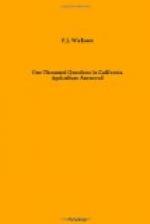Stover.
What is stover? How is it cut and handled?
Stover is corn fodder after the ears are taken off. The best time to cut the corn for stover is immediately after the kernel becomes dented and the leaves or blades commence to dry. Immediately after the ears are taken off, the stalks should be cut and stacked. The size of the shock depends upon the climate. If it is a foggly climate and stalks are green, it is better to make a smaller shock, but in the interior valley where the weather is warm it is best to make large shocks, so that the stacks will not dry up very rapidly.
Feed for Cows.
What shall I feed cows when they are fresh and when they are dry!
When they commence to freshen, give some green feed, such as alfalfa or corn; if possible, also give, say, two or three pounds of barley or bran, and gradually increase this for two or three weeks until six or seven pounds of bran or barley is being fed. Also give a small amount of hay. Bran may be rather expensive feeding and a substitute is being used. Take four parts of barley to one of bran and mix. With barley at its low price, this makes rather inexpensive feeding. Another substitute is to take the chopped alfalfa hay and barley. These are mixed thoroughly together and moistened. After the cow freshens and gives her full flow of milk, let her eat all the alfalfa hay she wants. A good ration is about 15 to 20 pounds of hay, 6 or 7 pounds of barley or bran and about 10 pounds of roots such as beets or mangels. When the cow is dry, pasture is the best food, supplemented with some green food.
Sorghum Silage.
Will Egyptian corn make good ensilage and at what time should it be cut to make the best feed for dairy cows?
Sorghum makes good silage. It must be cut while surely juicy enough, for it is a little more apt to dry out than Indian corn.
Barley for Hay Feeding.
Should the barley for hog feeding be rolled, ground or fed whole, dry or wet? Also, how much should be fed and how often to get best results?
To obtain the best results, the barley should be ground into a meal (not too fine) and have the hulls screened or floated out. This is best fed when made into a thick slop. Some good feeders believe in letting it stand until fermentation sets up, that is, gets a little sour. We prefer a sweet to a sour feed. However, hogs will do well on either, provided there is no change from sour to sweet. The change is the bad part. Hogs should be fed just the amount that they will clean up well, and no more. A hog should always be ready for his feed at feeding time. We would not feed oftener than twice a day: night and morning. — Chas. Goodman.
Sugar Beets and Silage.
Will sugar beets keep in a silo and how sugar beets rank as a hog feed?




